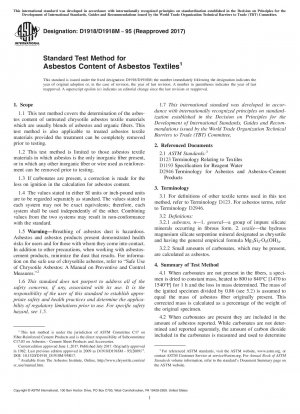ASTM D1918/D1918M-95(2017)
Standard Test Method for Asbestos Content of Asbestos Textiles
- Standard No.
- ASTM D1918/D1918M-95(2017)
- Release Date
- 1995
- Published By
- American Society for Testing and Materials (ASTM)
- Latest
- ASTM D1918/D1918M-95(2017)
- Scope
-
5.1 The asbestos content of asbestos textile materials is of major significance, since the percentage of asbestos present defines the grade of the textile and the approximate serviceability temperature for such materials.
5.2 This test method is considered satisfactory for acceptance testing of commercial shipments because: (1) current estimates of between-laboratory reproducibility are acceptable, (2) the test method has been used extensively in the trade for acceptance testing. In cases of dispute, the statistical bias, if any, between the laboratory of the purchaser and the laboratory of the seller should be determined with each comparison being based on testing randomized specimens from one sample of material.
5.3 The factor of 0.86 is based upon a measured average of 148201;% for the loss of water of crystallization on heating chrysotile asbestos to a temperature of at least 800°C [1470°F]. The calculated asbestos content may be in error if the actual mass loss differs from the 148201;% average.
5.4 If the specimen includes calcium carbonate (CaCO3), this compound is decomposed at 800°C [1470°F] and higher temperatures. No other carbonates are present in appreciable amounts.
5.5 If the textile specimen includes carbonates, the loss of mass observed during ignition will include the water of crystallization of the asbestos and carbon dioxide from the carbonates. If the specimen includes both carbonates and organic fiber the loss of mass will include water of crystallization of the asbestos, carbon dioxide from the carbonates, and the combustible part of the organic fibers. Failure to take proper account of these losses will result in lower grading of the material.
5.6 Asbestos textiles as used in normal applications are not subjected to a temperature where CaCO3 will decompose. Any CaCO3 contained will remain unchanged and as such offers excellent thermal insulation. It is therefore included in the calculation as part of the asbestos content.
5.7 The mass of the original carbonate and the residual oxide formed on ignition of the carbonate in any specimen can be calculated from the amount of carbon dioxide evolved from a known mass of the specimen. The calculated values are used in the determination of the asbestos content of specimens which include carbonate.
1.1 This test method covers the determination of the asbestos content of untreated chrysotile asbestos textile materials which are usually blends of asbestos and organic fibers. This test method is also applicable to treated asbestos textile materials provided the treatment can be completely removed prior to testing.
1.2 This test method is limited to those asbestos textile materials in which asbestos is the only inorganic fiber pres......
ASTM D1918/D1918M-95(2017) Referenced Document
- ASTM D1193 Standard Specification for Reagent Water*, 1999-04-20 Update
- ASTM D123 Standard Terminology Relating to Textiles*, 2023-09-14 Update
- ASTM D2946 Standard Terminology for Asbestos and Asbestos-Cement Products*, 1998-04-20 Update
ASTM D1918/D1918M-95(2017) history
- 1995 ASTM D1918/D1918M-95(2017) Standard Test Method for Asbestos Content of Asbestos Textiles
- 1995 ASTM D1918/D1918M-95(2009)e1 Standard Test Method for Asbestos Content of Asbestos Textiles
- 1995 ASTM D1918-95(2004)e1 Standard Test Method for Asbestos Content of Asbestos Textiles
- 1995 ASTM D1918-95(2004) Standard Test Method for Asbestos Content of Asbestos Textiles
- 1995 ASTM D1918-95(1999) Standard Test Method for Asbestos Content of Asbestos Textiles

Copyright ©2024 All Rights Reserved